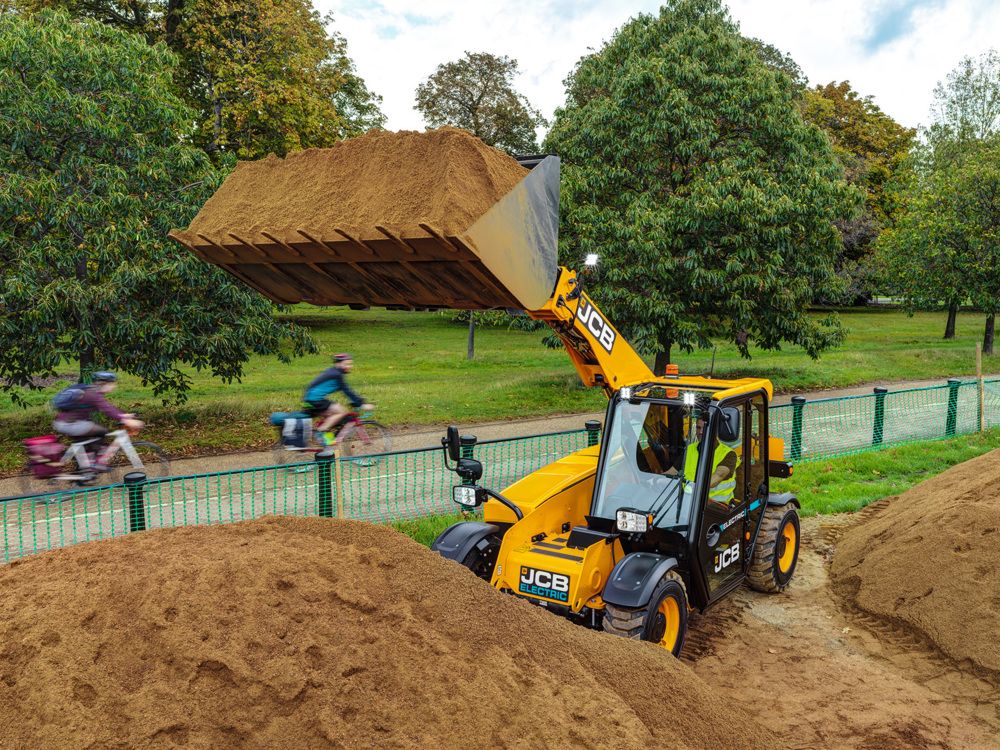
Telehandler: Loading at great heights
Flexible loading thanks to the telescopic arm with the telehandler
When it comes to loading and handling goods, hardly any other machine is as popular as the telehandler. Unlike wheel loaders, telescopic handlers are also suitable for transporting and stacking goods at great heights thanks to their extendable telescopic arm. They are therefore particularly popular in logistics or as a machine for transporting materials on construction sites. However, telehandlers are also popular in agriculture, for example for storing large bales of fodder.
What are the design features of a telehandler?
Of course, the telescopic handler is primarily characterized by its telescopic mast, which allows it to work flexibly at different lifting heights. The average lifting height is between 4.00 m for small telehandlers and up to 17.50 m for larger series. However, there are also special series that achieve significantly higher lifting heights. How many tons a telehandler can lift also depends significantly on the model selected: As a rule of thumb, it can be assumed that the dead weight of the telehandler is around 1.5 to 2.7 times the lifting capacity. Depending on the model, the rated load capacity can vary from around one tonne for small telehandlers to 33 tons for specially developed construction telehandlers.
Depending on their design, telehandlers are divided into rigid frame machines, semi-rigid frame machines and rotor machines, whereby the vehicle frame on the front axle of semi-rigid frame machines can be swiveled sideways and rotor machines even have an upper carriage that can be rotated indefinitely. Telescopic loaders are mainly driven by a hydrostatic transmission with all-wheel drive. In addition, telescopic handlers are characterized by a driver's cab, which is located to the side of the lift arm.
In a nutshell
The characteristic features of a telehandler include
- Telescopic mast
- Average lifting height: 4-17.5 m
- Rated capacity varies depending on model
- Rigid frame machines, semi-rigid frame machines or rotor machines
- Cabin positioned to the side of the telescopic boom
- Often with hydrostatic drive
- All-wheel drive
What is the difference to a telescopic wheel loader?
Telehandler or telescopic wheel loader? Even professionals often find it difficult to distinguish between these two types of machine, as they are very similar. Nevertheless, there are a few differences: Externally, telescopic handlers and telescopic wheel loaders differ in the fact that the telescopic handler usually has its telescopic arm on the right-hand side, while the cab is shifted sideways to the left. The telescopic wheel loader, on the other hand, is a mixture of a wheel loader and a telescopic loader. This means that the driver's cab and telescopic arm are arranged in the middle, so that driving is very similar to driving a wheel loader in terms of clarity. In addition, the telescopic wheel loader has a narrow track width, so that, similar to the wheel loader, a very high level of maneuverability is achieved. However, in contrast to the somewhat wider telehandler, this reduces stability. Due to their design, telescopic wheel loaders are also only available with lower lifting heights of 4-5.5 m.
In a nutshell: Differences between a telescopic handler and a telescopic wheel loader
- Telescopic arm arranged on the right
- Cabin shifted to the left
- Higher track width
- Less maneuverability
- Greater stability
- Higher lifting heights
What driving license do you need for a telehandler?
Telehandlers are self-propelled work machines and may therefore be driven with a category L or B driving license in Germany as long as their maximum design speed does not exceed 25 km/h. For telehandlers that travel at speeds of up to 40 km/h, a category T driving license is required for agricultural use or a C1 or C driving license (depending on the permissible total weight). For commercial use, an operator's license is also required. A distinction is made between the following levels:
- Level 1: General qualification for telescopic forklift trucks (rigid body, forks, loading shovel, load hook)
- Level 2a: Additional qualification: rotating uppercarriage, crane operation
- Level 2b: Additional qualification for use as an aerial work platform
Which brands offer telehandlers?
A large number of companies now offer telehandlers in their portfolio. Depending on the company, the telehandlers are developed for general use or for special applications (e.g. heavy-duty, construction, agriculture). We currently offer telehandlers from the following brands: